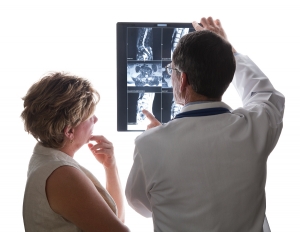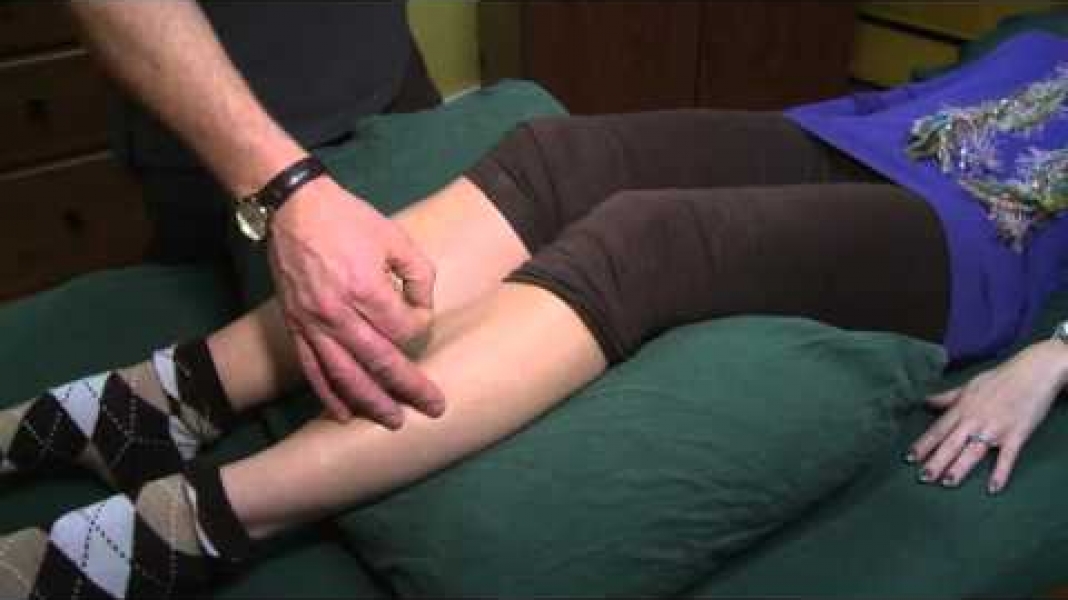
Doctor Viewing Scans With Patient
Acupuncture for back pain is one of the most common reasons people come and see us at our clinic. You can hardly find a person 40 years of age in our new society who has never had back pain! We have come to accept it as part of growing older and sitting most of the day.
The most common story is to for someone to injure him or herself after a period of inactivity when getting back into a sport or workout or doing a physical task. Here his or her weakened state was vulnerable to injury. Back pain is usually preventable, and if you are afflicted by it, it is usually treatable. This is especially so if you have good days and bad days for your back issue, which means some things make it better and some things make it worse.
Back pain should not just be ignored or endured without investigation, since it can be a medically important symptom that needs a proper diagnosis. This is why we like it when a client who presents with back pain for the first time first sees a medical doctor or physiotherapist.
Back pain can come in one of 4 main categories; acupuncture can help with A) non-severe back problems and B) some indirect causes of back pain ….see below.
Read more about acupuncture in general.
-
A. Most common – non-severe back problems
Doctors are trained to recognize and categorize the most common causes of back pain since they are common. These include:
- vertebral dysfunctions especially facet joint and early stage disc related problems
- musculo-ligamentous strain or mild injuries
- spondylosis, a degenerative ostheoarthritis of the spine
- sacroiliac dysfunction, or pain in the SI joint usually due to pelvis misalignment issues
People who come to get acupuncture at our clinic commonly have these diagnosed conditions, but the drugs they have taken often are not working any more and not addressing the root cause. In this context then acupuncture for back pain works by improving function so a person can move better. Better movement coupled with some instruction on posture and exercises for the back turns into a cycle of less pain, and better movement….!
-
B. Indirect causes of back pain:
- On the other hand, there are a cluster of conditions that do not affect the back directly, but still can be associated with back pain. Conditions like fibromyalgia and chronic fatigue and other referred pain phenomena may be expressed through bioactive zones. Oriental practitioners first described these zones and represents the most common acupuncture points located along connective tissue planes. In these situations, typical painkillers may be not effective to address the root of the problem. Here, additional measures need to be investigated to diagnose and treat the roots of the problem.
- Here, acupuncture initiates small, incremental and self-sustaining effects through relaxing the body’s flight or fight responses. On the other hand, a drug approach, although more dramatic and effective in the short term, usually has side effects. Drugs can have negative side effects, be less effective over time, and create a dependency which is not sustainable in the long term. Acupuncture on the other hand works by supporting the body’s inherent healing systems to create better function (known medically as homeostasis), whereas drug therapy for pain can often creates imbalances that still need to be addressed later.
-
C. Progressive structural back problems:
- Next are the conditions are more difficult to diagnose, since they initially look like the first group A. All of these would first require medical attention and special tests like Xray or MRI and expert evaluation. They are:
- spondylolisthesis, the displacement of the vertebra
- ankylosing spondylitis, an autoimmune process in the spine
- significant trauma to back, disc herniation
All of these conditions can start as a regular back pain resembling muscular strain or disc related problem. Eventually these can progress to more advanced structural pathology diagnosed too late for early intervention. To make it more complicated, some patients show significant degeneration or disc pathology under imaging. This then can hide or distract the best diagnosis and real source of pain. Acupuncture can help in these circumstances as a secondary support to complement the medical treatment and help the client cope.
-
D. Medically urgent back problems:
- Next are conditions which are red flags to a doctor, and are medically urgent. They are often discovered by an obvious history. But, the doctor needs to investigate a further, since back pain here is usually a secondary issue caused by a serious more underlying problem. They indicate the need for immediate treatment. Red flag symptoms include a sudden intense or constant pain, with history of cancer, and/or elevated temperature, a recent significant trauma or weight loss, neurological deficit (lose of sensation, or numbness/tingle, or muscle weakness), or a bladder, kidney or bowel dysfunction. The doctor pays attention to a patient’s medications too. Especially drugs like anticoagulants or corticosteroids, as well as potential drug or alcohol abuse. Another red flag warranting further investigation here is if the problem does not improve over time.
Serious back pain disorders that are usually recognized by doctors can present as an acute and severe back pain. These need immediate medical attention and include:
- ruptured aortic aneurysm, retroperitoneal hemorrhage due to anticoagulants
- cauda equina compression
- cancer
- kidney pathology
- severe acute infections of vertebra, or pelvic inflammatory disease
- Summary: The back pain problems that are most responsive to acupuncture are the first two groups (A and B) – the common early stages of physical stress and wear and tear on the muscles and sinews and also the indirect type of back pain such as fibromyalgia.
For the other two back problems which need a doctor’s attention (B, C above), acupuncture and massage and other supportive practices complement what the medical system does. Acupuncture for these types of back pain may not change the development of these particular problems, but indeed, may decrease pain and improve a client’s function and comfort level considerably.
Research showing evidence for back pain:
Acupuncture for Low Back Pain: An Overview of Systematic Reviews. L Liu et al, Evidence Based Complementary Alternative Medicine v.2015; 2015PMC4364128… Conclusion: Systematic reviews of variable quality showed that acupuncture, either used in isolation or as an adjunct to conventional therapy, provides short-term improvements in pain and function for chronic LBP. More efforts are needed to improve both internal and external validity of systematic reviews and RCTs in this area.




